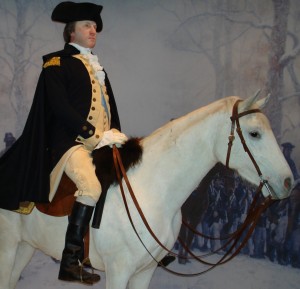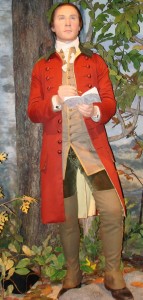For the traveling exhibit “Discover the Real George Washington: New Views from Mount Vernon,” Dr. Jeffrey H. Schwartz, a forensic anthropologist at the University of Pittsburgh forensically recreated accurate, life-sized figures of George Washington at the ages of 19, 45, and 57. The catch was that Schwartz wasn’t allowed access to Washington’s bones.
In my previous blog post, I described the materials and techniques Schwartz used to surmount this challenge. Although some of the more exacting details that I mention below are only visible in close-up photographs of each figure’s facial features, for those who study body language, Schwartz’s overall impressions do come through. Let’s take a look at the results.
 Schwartz says that Washington on Inauguration Day, at the age of 57, was the easiest figure to create. Just a few years earlier, Jean-Antoine Houdon had created a three-dimensional life mask, bust, and statue of Washington: a gift to any forensic anthropologist. When Washington took the Oath of Office, he had only one natural tooth in his mouth. Since tooth loss softens the jaw line, Schwartz gave Washington an amorphous jaw line. He also gave him the puckered lips of an older man. For the inauguration, Washington, who never wore a wig, had his own hair powdered.
Schwartz says that Washington on Inauguration Day, at the age of 57, was the easiest figure to create. Just a few years earlier, Jean-Antoine Houdon had created a three-dimensional life mask, bust, and statue of Washington: a gift to any forensic anthropologist. When Washington took the Oath of Office, he had only one natural tooth in his mouth. Since tooth loss softens the jaw line, Schwartz gave Washington an amorphous jaw line. He also gave him the puckered lips of an older man. For the inauguration, Washington, who never wore a wig, had his own hair powdered.
 Washington at Valley Forge, age 45, was more difficult for Schwartz to capture. At this point in his life, the Commander of the Continental Army still had some teeth in the front of his mouth, so he didn’t have the taut lips of a man trying to hold a full set of 18th-century dentures in his mouth without the help of a product like Polygrip. Schwartz also wanted to capture Washington’s charisma, the element about him that helped him hold the army together through that bitterly cold winter. Thus Washington has “tired eyes” with crows feet, and between his eyes, his brow is furrowed. Note how Washington’s feet hang below the torso of his horse. Horses in the 18th century were smaller than they are now, however, sources report that Washington’s limbs were so long and lanky that he could wrap his legs around the belly of his horse, thus contributing to his excellent equestrian skills.
Washington at Valley Forge, age 45, was more difficult for Schwartz to capture. At this point in his life, the Commander of the Continental Army still had some teeth in the front of his mouth, so he didn’t have the taut lips of a man trying to hold a full set of 18th-century dentures in his mouth without the help of a product like Polygrip. Schwartz also wanted to capture Washington’s charisma, the element about him that helped him hold the army together through that bitterly cold winter. Thus Washington has “tired eyes” with crows feet, and between his eyes, his brow is furrowed. Note how Washington’s feet hang below the torso of his horse. Horses in the 18th century were smaller than they are now, however, sources report that Washington’s limbs were so long and lanky that he could wrap his legs around the belly of his horse, thus contributing to his excellent equestrian skills.
 The 19-year-old Washington, depicted in this image as surveying in the wilderness, has a pronounced angle in his back jaw because he still has all his teeth. He also has more fullness in his cheeks, a smaller nose and ears, and fuller lips than the older versions of himself. Washington was well-known for enjoying his time in the wilderness. Therefore, Schwartz gave the young Washington a smile behind his eyes, and lips tilted up ever so slightly at the corners, as if he’s delighting in his time with nature, musing that his future looks bright.
The 19-year-old Washington, depicted in this image as surveying in the wilderness, has a pronounced angle in his back jaw because he still has all his teeth. He also has more fullness in his cheeks, a smaller nose and ears, and fuller lips than the older versions of himself. Washington was well-known for enjoying his time in the wilderness. Therefore, Schwartz gave the young Washington a smile behind his eyes, and lips tilted up ever so slightly at the corners, as if he’s delighting in his time with nature, musing that his future looks bright.
What do you think of Jeffrey Schwartz’s creations?
**********
Did you like what you read? Learn about downloads, discounts, and special offers from Relevant History authors and Suzanne Adair. Subscribe to Suzanne’s free newsletter.
